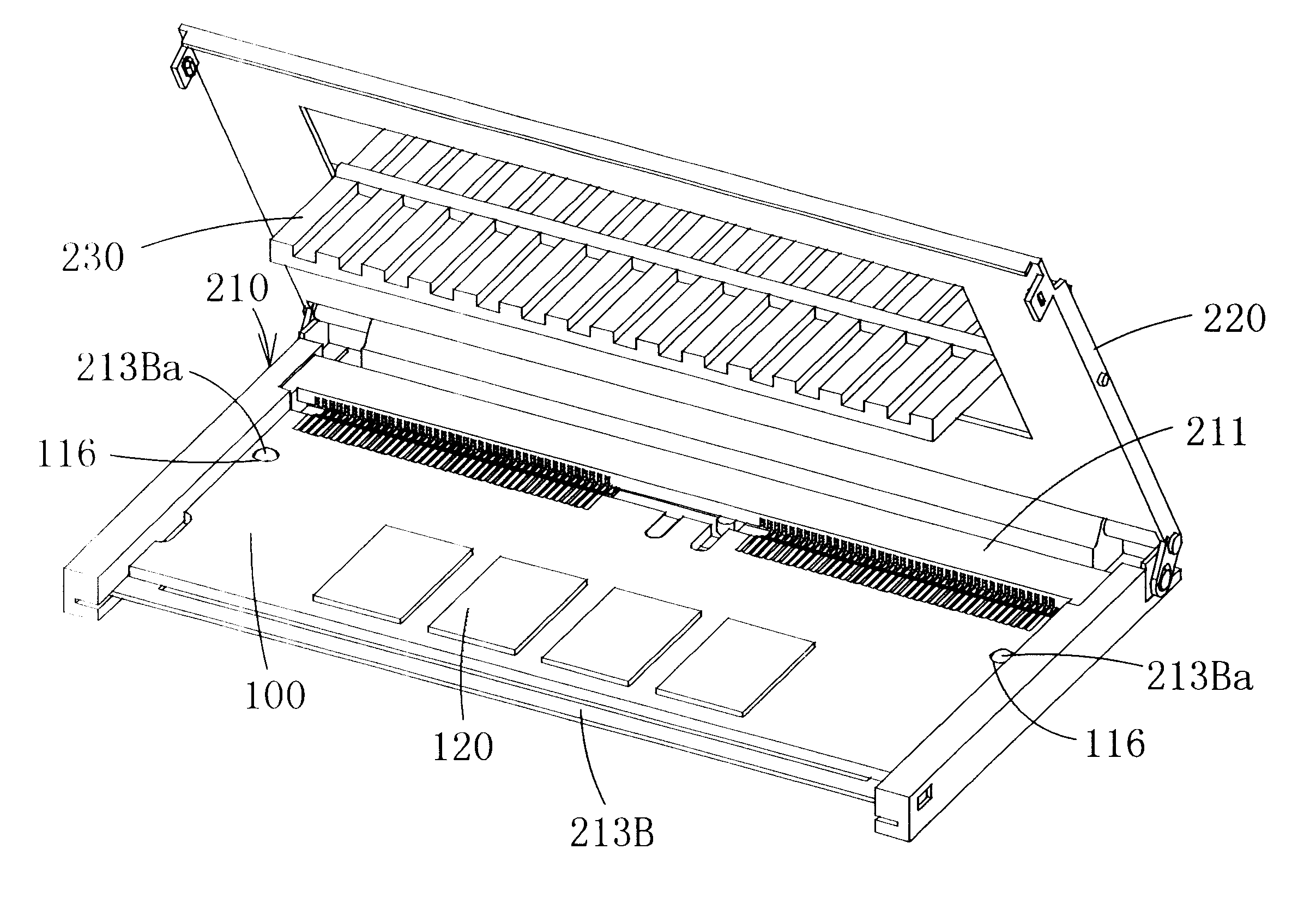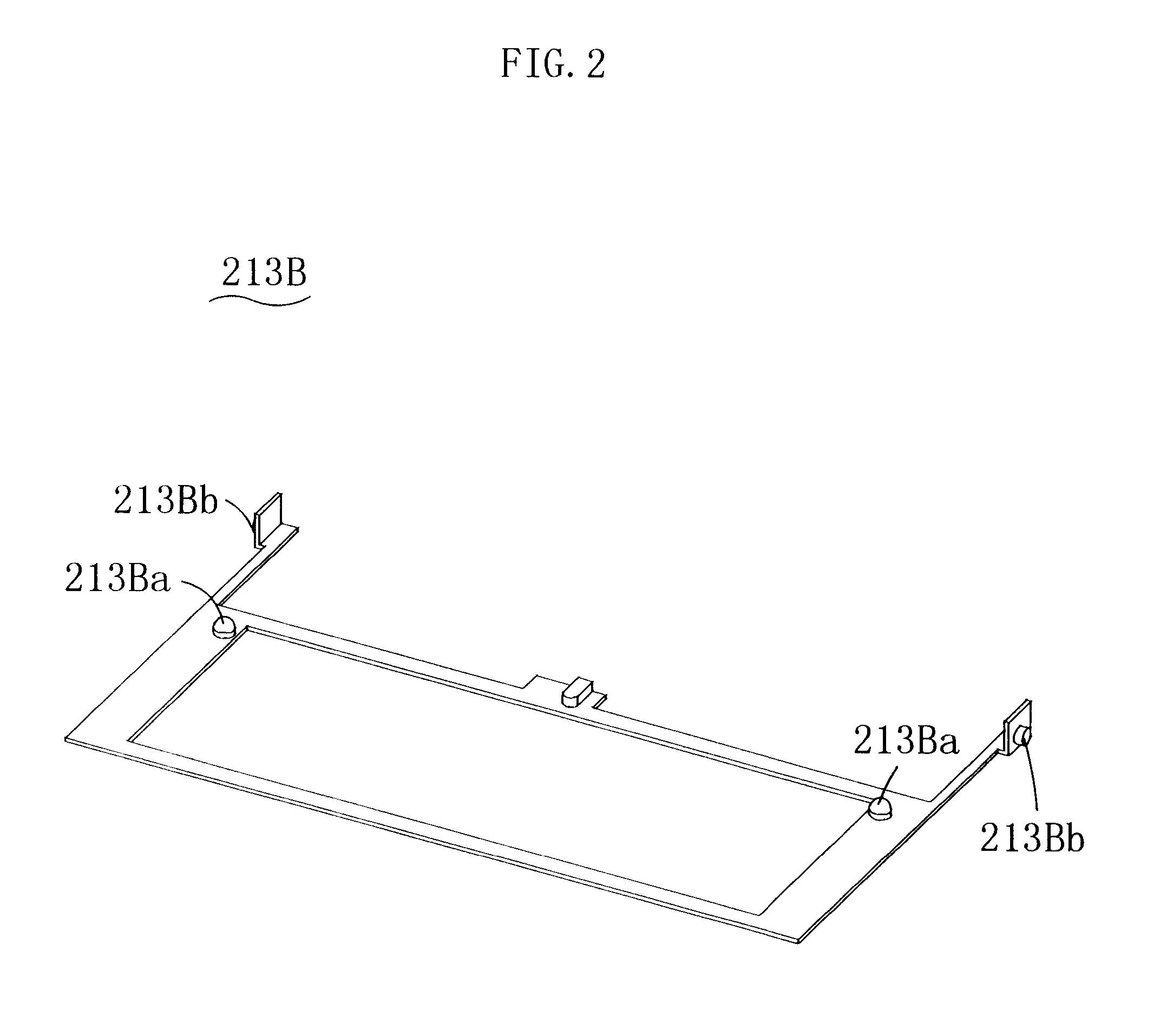Connector for module
- Summary
- Abstract
- Description
- Claims
- Application Information
AI Technical Summary
Benefits of technology
Problems solved by technology
Method used
Image
Examples
first embodiment
the connector for module is mounted on a printed circuit board 300 by, for example, soldering the solder tails of the contacts 212a, 212b onto the printed circuit board 300 and, when necessary, fixing the bases 213A of the supporting part 213 on the printed circuit board 300. When a module 100 is to be fitted into the connector 200, the module 100 is placed on the slider 213B when the rear end of the metal cover 220 is up, then the rear end of the metal cover 220 is lowered. As a result, the slider 213B will move forward, and the front side 111 of the module 100 will enter into the groove 211a of the receiving part 211 and the front side 111 will be inserted into the space between the contacts 212a, 212b and the conductive pads 130 will contact the contacts 212a, 212b. When the metallic cover 220 is put over the module 100 and engaged to the connector body 210, the module 100 will be sandwiched between the supporting part 213 and the metallic cover 220 and kept in the connection pos...
second embodiment
With the arrangement of the second embodiment, as the contacting surface of the heat sink 230 is reliably brought to face-to-face contact with the surfaces of semiconductor chips 120, the heat of the semiconductor chips 120 is efficiently transferred to the heat sink 230. Hence the semiconductor chips 120 are cooled well and their operation is maintained stably. Moreover, as the heat sink 230 is energized towards the module by the elastic members 240, any error in the clearance between the heat sink 230 and the semiconductor chips 120 will be absorbed, and the contacting face of the heat sink 230 will contact the surface of the semiconductor chips 120 with an appropriate pressure. Hence the dispersion of the heat transfer performance from the semiconductor chips 120 to the heat sink 230 among the products can be reduced.
FIG. 19 and FIG. 20 show the third embodiment. This third embodiment differs from the second embodiment in that the location of the hinge axis 231 is at the front en...
fourth embodiment
With the arrangement of the fourth embodiment, as the contacting surface of the heat sink 230 is reliably brought to face-to-face contact with the surfaces of semiconductor chips 120, the heat of the semiconductor chips 120 is efficiently transferred to the heat sink 230. Hence the semiconductor chips 120 are cooled well and their operation is maintained stably. In this case, as the angle of fitting the heat sink 230 to the metallic cover 220 is variable in all directions, the ratio of success in the above-mentioned face-to-face touching is improved. Hence cooling of the semiconductor chips 120 is promoted further and their operation is maintained more stably. Moreover, as the heat sink 230 is energized towards the module by this supporting structure, any error in the clearance between the heat sink 230 and the semiconductor chips 120 will be absorbed, and the contacting face of the heat sink 230 will contact the surface of the semiconductor chips 120 with an appropriate pressure. H...
PUM
 Login to View More
Login to View More Abstract
Description
Claims
Application Information
 Login to View More
Login to View More - R&D
- Intellectual Property
- Life Sciences
- Materials
- Tech Scout
- Unparalleled Data Quality
- Higher Quality Content
- 60% Fewer Hallucinations
Browse by: Latest US Patents, China's latest patents, Technical Efficacy Thesaurus, Application Domain, Technology Topic, Popular Technical Reports.
© 2025 PatSnap. All rights reserved.Legal|Privacy policy|Modern Slavery Act Transparency Statement|Sitemap|About US| Contact US: help@patsnap.com



